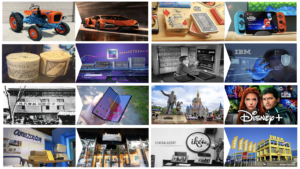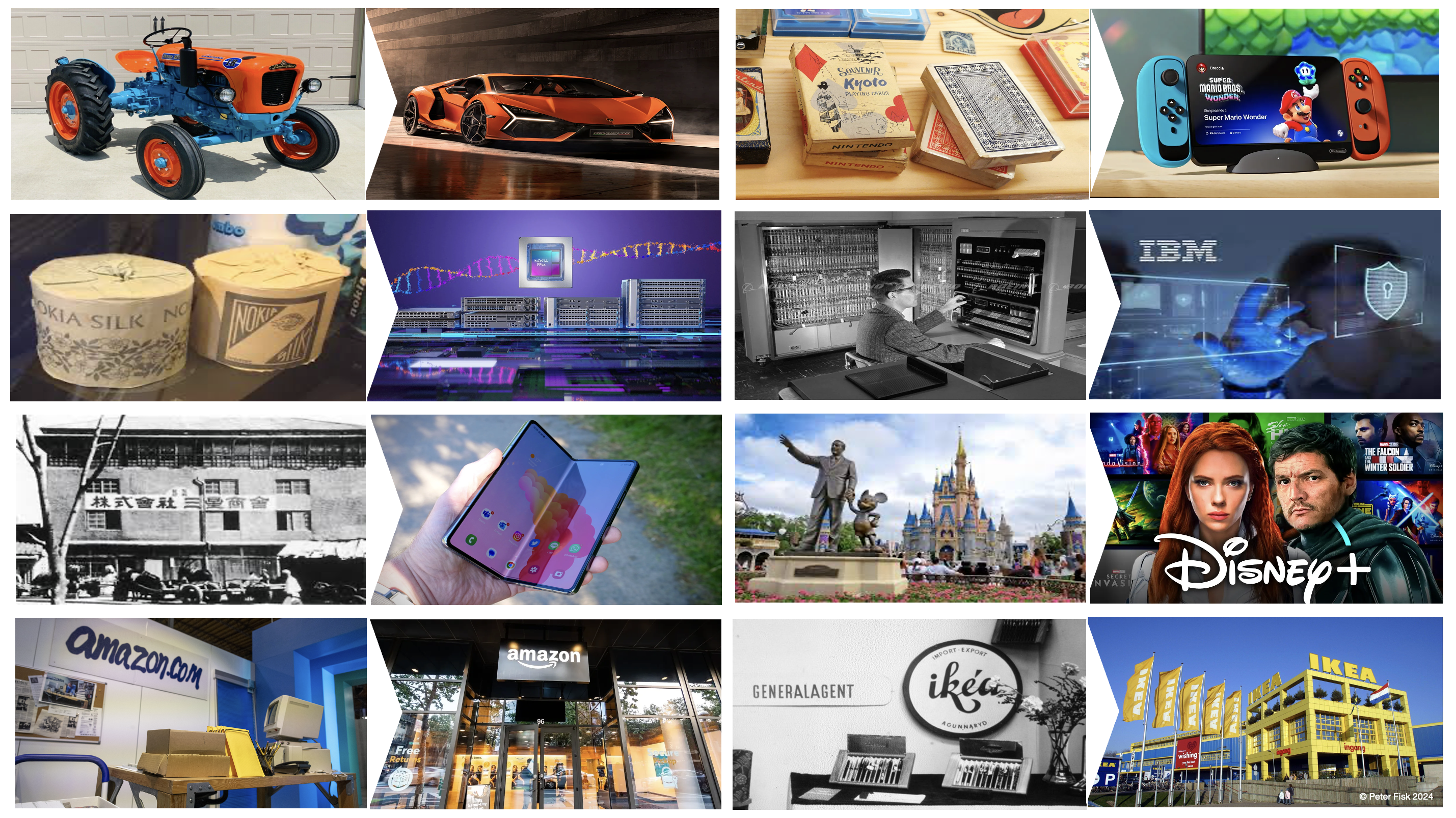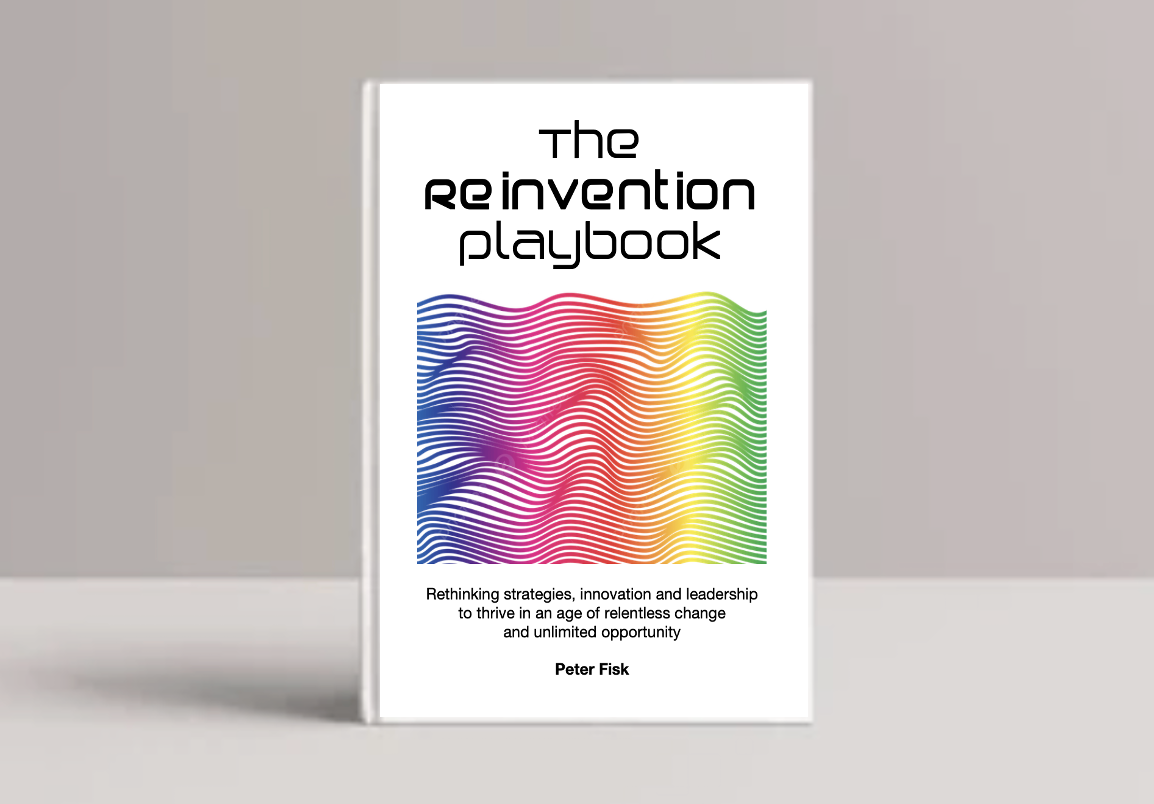The Reinvention Playbook … Lamborghini was a tractor company, Samsung was a grocery store … Reinventing strategies, brands and business models to stay relevant in an ever-changing world
November 30, 2024

Lamborghini was a tractor company. Samsung was a grocery store. Lego was a wooden toyshop. Nintendo made playing cards. LG was a facial cream. IKEA was a pen company.
In today’s fast-changing markets, the ability to reinvent yourself can often make the difference between thriving and fading into irrelevance. Reinvention isn’t just a buzzword—it’s a crucial survival strategy that allows companies to evolve in response to shifting market dynamics, changing consumer expectations, and disruptive technologies.
This reinvention can take many forms, from overhauling business models to reimagining a company’s purpose and vision. By embracing reinvention, organisations can chart new courses, seize emerging opportunities, and secure long-term success.
The need for reinvention
Most organisations are unlikely to survive the next 10 years, unless they reinvent themselves. Rapidly emerging technologies, evolving consumer attitudes and behaviours, and increasing competition all drive the need for businesses to adapt.
The average lifespan of companies in the S&P 500 has decreased from 67 years in 1920 to about 15 years today. This trend is expected to continue, with half of the companies in the S&P 500 predicted to be replaced within the next 10 years if current trends continue.
Traditional business models that once guaranteed success may now be insufficient in the face of new challenges. Companies that fail to reinvent themselves risk becoming obsolete. Conversely, those that embrace change can find new growth avenues, strengthen their competitive edge, and build deeper relationships with customers.
Reinvention is a response to this dynamic environment. It goes beyond mere improvement or iteration; it involves rethinking how a company operates, how it connects with customers, and how it delivers value. Reinvention can be intentional and strategic, or it can be a reaction to external pressures—economic shifts, technological advances, or shifts in consumer behaviour—that demand immediate change.
Great examples of reinvention
The business world abounds with stories of reinvention – both start-ups who quickly realise they need to adapt their initial dreams, to well established companies who ride with changing nature of consumers and markets. Instagram was originally called Burbn, enabling users to share their location, typically bars and restaurants. Youtube started as a video dating site called Tune In Hook Up.

The best stories of reinvention are in larger companies. This is where a profound change in thinking is demanded to sustain long-term success. These companies realised that as the world changes, they have to change. Not just in creating new products and services, but in their fundamental purpose, sector, business model, strategy, organisation and culture:
- Nokia: from paper mill to a rubber company to a ship builder, to a telecoms business known for mobile phones and now focuses on network infrastructure.
- IBM: from hardware manufacturer to IT services and consulting firm, including cloud computing, and AI innovations like IBM Watson.
- Alibaba: from B2B e-commerce platform called China Pages into a consumer platform (AliExpress) to entertainment, online grocery (Hema), and healthcare.
- Disney: from animation and film production, into television, theme parks, and streaming platform with brands like Marvel and Star Wars.
- Samsung: from textiles and groceries into consumer electronics like the Galaxy mobile phone series, and one of the largest producers of semiconductors.
- Nintendo: from playing card manufacturer, into an iconic video game company behind franchises like Super Mario and Zelda.
- Grupo Bimbo: from a small Mexican bakery, to the world’s largest bakery products company (incl. Sara Lee and Entenmann’s) and health foods.
- Amazon: from online bookstore into an e-commerce “everything store”, to cloud services (AWS), streaming (Prime Video), and AI-driven logistics.
- Siemens: from electrical engineering and telegraphs, to digital infrastructure healthcare tech (Siemens Healthineers), and energy efficiency solutions.
- Natura: from cosmetics made from natural ingredients in Brazil, to a global portfolio of sustainable brands including Aesop and The Body Shop.
- Slack: from video game company called Tiny Speck with a game called Glitch to become a leading workplace collaboration and productivity tool.
- Tata: from steel and heavy industry, into automotive (eg acquiring Land Rover Jaguar), to hospitality, food and beverage, and a global technology provider.
- Netflix: from DVD rental by mail, into a streaming service and became a major content producer with award-winning original productions, and now gaming.
- Paypal: from online payments for eBay transactions, to a global digital payment platform, including peer-to-peer transfers (via Venmo), credit, and crypto.
- Shopify: from online store for snowboarding equipment, to become an e-commerce platform powering retail businesses worldwide.

Reinventing every aspect of business
Reinvention touches every facet of business: from strategy and business models to culture, leadership and performance. Below, we explore how each of these dimensions is being reimagined by forward-thinking organisations around the world:
Reinventing strategy … from predictive planning to adaptive platforms
Traditional strategic planning—anchored in stability, annual reviews, and five-year roadmaps—has given way to fluid, real-time strategy. In a world of relentless change, strategy must be a living process, where organisations continuously sense shifts in the market and respond fast.
DBS Bank in Singapore exemplifies this shift. Once a staid local bank, DBS has reinvented itself as a tech company with a banking license. Its “GANDALF” strategy (inspired by global tech giants) enables it to evolve its digital platforms, experiment with new ventures, and lead Asia’s fintech revolution. Strategic agility is now central, with teams empowered to pilot and scale ideas rapidly, aligned to customer needs and ecosystem opportunities.
Reinventing innovation … from R&D Labs to open ecosystems
Innovation can no longer be a siloed department—it must be embedded across the organisation and expanded into networks and ecosystems. The best innovators now blend human creativity with AI-powered insights, internal capabilities with external partnerships.
GitLab, a DevOps company born remotely, thrives by enabling distributed, transparent, and continuous innovation. Meanwhile, DeepMind, based in the UK, reimagines innovation through AI to solve complex problems—from protein folding to energy optimisation. The key is dynamic learning and collective intelligence.
Reinventing business models … from pipelines to platforms
The shift from ownership to access, products to services, and control to collaboration is redefining business models. Traditional linear value chains are giving way to ecosystem thinking and platform dynamics.
Shopify, a Canadian e-commerce company, didn’t just build a tool for online stores—it built a global platform where millions of merchants, developers, and partners co-create value. Its business model scales through network effects, embedded services, and third-party integrations. Similarly, Tesla disrupted the auto industry by integrating energy, software, and services into a vertically integrated platform model.
Reinventing brands … from identity to activism
A brand today is no longer just a logo or marketing message—it’s a vehicle for values, a social actor, and a lived experience. Customers expect brands to take a stand on societal and environmental issues, and deliver authentic value in every interaction.
Patagonia has redefined what it means to be a purpose-driven brand. From suing the US government over public lands to giving away ownership to fight climate change, the brand leads with bold actions. In South Korea, Amorepacificrepositions beauty as wellness and sustainability, aligning product innovation and brand storytelling with ecological responsibility.
Reinventing experiences … from transactions to transformations
Customers today don’t just buy products—they buy experiences, outcomes, and shared identities. Experience is the new differentiator. Reinvention means designing every touchpoint around the customer’s life—not the company’s processes.
Disney has masterfully reinvented its customer experience through Disney+, blending content, data, and personalization across digital and physical worlds. On Running, the Swiss sportswear brand, combines tech-infused shoes, sustainability stories, and community experiences to offer more than athletic gear—it sells a performance lifestyle with purpose.
Reinventing organisations … from hierarchies to networks
Rigid hierarchies and departmental silos stifle agility and innovation. The new organisation is a living system—flat, cross-functional, self-organising. It thrives on speed, fluidity, and empowered teams.
Haier in China has dismantled its traditional corporate hierarchy to become a “microenterprise” ecosystem—over 4,000 autonomous teams run as mini start-ups within the larger group. This radical decentralisation fosters entrepreneurship, responsiveness, and accountability at scale. In Europe, Spotify introduced “squads” and “tribes” to scale agile work structures globally.
Reinventing culture … from control to creativity
Culture is no longer a background issue—it’s the front line of transformation. Today’s high-performing cultures value experimentation, inclusivity, resilience, and purpose. Reinventing culture means building psychological safety, growth mindsets, and the freedom to challenge.
Netflix famously champions a culture of “freedom and responsibility.” Employees are trusted to act in the company’s best interest and empowered to make bold decisions. Unilever, meanwhile, embeds purpose at the core of its culture, training thousands of “purpose ambassadors” and linking employee engagement to social impact.
Reinventing leadership … from command to co-creation
The role of the leader is evolving—from visionary and controller to coach and catalyst. In volatile times, the most effective leaders are those who inspire, listen, learn fast, and lead through shared purpose.
Satya Nadella’s transformation of Microsoft is one of the clearest examples of leadership reinvention. He shifted the culture from know-it-all to learn-it-all, prioritised empathy and curiosity, and opened the company to partnerships and openness. In Africa, Phuthi Mahanyele-Dabengwa, CEO of Naspers South Africa, champions inclusive leadership, digital empowerment, and long-term innovation for impact.
Reinventing performance … from profit to progress
Finally, the definition of business success is shifting. Performance is no longer measured solely by short-term financial results, but by broader metrics of long-term value—social, environmental, and economic. The shift to stakeholder capitalism is redefining what great looks like.
Danone became the first listed company to adopt “Entreprise à Mission” status in France, embedding social and environmental goals into its legal structure. It tracks health, sustainability, and trust alongside revenue and margins. Meanwhile, Schneider Electric ranks as one of the world’s most sustainable companies, linking executive compensation to ESG outcomes.
Reinvention … as a Continuous Capability
What unites these examples is not a one-time pivot, but an ongoing capacity to reinvent. Reinvention is not a project—it’s a mindset, a muscle, and a method. It requires ambidexterity: the ability to exploit today while exploring tomorrow. It means building systems that sense and respond to change, and cultures that embrace uncertainty as a source of opportunity.
From Indian tech giants like Reliance Jio, creating a digital lifestyle ecosystem, to Nordic innovators like IKEA, rethinking circularity and low-carbon living, the future belongs to the reinventors—those willing to challenge themselves before the market does.
As Peter Drucker once said, “The greatest danger in times of turbulence is not the turbulence—it is to act with yesterday’s logic.” Reinvention is the antidote to irrelevance. In a world of relentless change, the only sustainable strategy is to stay in motion.
Business impact of reinvention
Reinventing a company can initially be about survival, but it is also about profitable growth, and also having a broader net positive impact on the environment and society. The impact of reinvention varies depending on the company, the industry, and the strategies adopted, but several studies and real-world examples show that companies can see significant benefits from transformation efforts. Below are some key statistics and examples of how reinvention can impact financial performance:
Companies that have successfully executed digital transformations can experience up to a 20% improvement in cash flow and 10-15% revenue growth on average. Additionally, they report a 30-50% reduction in costs due to efficiency improvements and better customer experiences. (McKinsey, 2022). Since embracing the Azure cloud platform, Microsoft’s cloud revenue surged. In Q2 2021, Azure grew by 50% year-over-year, helping Microsoft’s total revenue increase by 17%, and net income grew by 33%. By focusing on cloud computing, Microsoft transformed from a traditional software company into a dominant player in cloud services, with Azure contributing nearly 30% of its total revenue.
Companies that complete successful transformations outperform the market by 3x over a period of five years. Bain also found that about 70% of transformations fail, meaning that successful reinvention can produce outsized returns for companies that get it right. (Bain 2018). Between 2012 and 2022, Netflix’s market value increased from $8.5 billion to over $200 billion, reflecting a 25x increase in value. Its subscriber base grew from 23 million in 2011 to over 230 million in 2022. Revenue grew from $3.2 billion in 2012 to $31.6 billion in 2022, with net income growing from $226 million to $4.5 billion in that time.
Companies that embrace sustainability found that those with a focus on environmental, social, and governance (ESG) goals have outperformed the market by 3-6% annually over a 10-year period. These companies also see higher employee satisfaction and brand loyalty (HBR 2019). After acquiring The Body Shop in 2017 and Aesop in 2012, Natura’s revenue grew by 45% between 2017 and 2020, and the company became a leader in eco-friendly products. Natura’s focus on sustainability and natural ingredients has also led to higher customer loyalty and brand equity, resulting in strong market share in Latin America and globally.
Companies using data analytics to improve operations and customer experience are 5x more likely to make faster decisions and 3x more likely to achieve above-average profitability compared to their peers. Inditex, revolutionized the retail fashion industry by using real-time data analytics to quickly adjust inventory and respond to customer preferences. By integrating big data into its supply chain and production processes, Zara reduced inventory waste, shortened lead times, and improved profit margins. As a result, Zara has maintained high same-store sales growth and profitability. The company has grown from $10 billion in revenue in 2002 to over $32 billion in 2022, with operating profit margins consistently above 10%.
Leading the revolution
While reinvention can yield enormous rewards, it is not without its challenges. Companies must be willing to take risks, confront failure, and often make tough decisions about the direction of their business. Reinvention may require major investments in research and development, technology, or talent acquisition. Additionally, the need to balance short-term performance with long-term vision can be a difficult tightrope to walk.
One of the biggest challenges of reinvention is overcoming internal resistance to change. Employees and leaders alike may be attached to the company’s legacy practices and products. For successful reinvention, a company must foster a culture of innovation and openness to new ideas, even if they challenge the status quo.
Reinvention is a complex, multifaceted process that requires bold thinking, creativity, and leadership. Companies that successfully reinvent themselves are able to navigate changing market conditions, anticipate future trends, and build deeper connections with their customers. Whether it’s through redefining a business model, refreshing a brand, or embracing new technologies, reinvention is a key to enduring success in today’s fast-paced, ever-evolving business environment.
As we look to the future, businesses that are committed to reinvention will continue to be the ones that thrive—those that can reinvent their products, their organizations, and their leadership will set the stage for the next era of innovation and growth. Reinvention is not a one-time event; it is an ongoing process that requires continuous adaptation, learning, and forward thinking. It is the hallmark of resilient, forward-thinking companies that refuse to rest on their laurels and instead embrace the constant change that defines the modern business world.
More from the blog